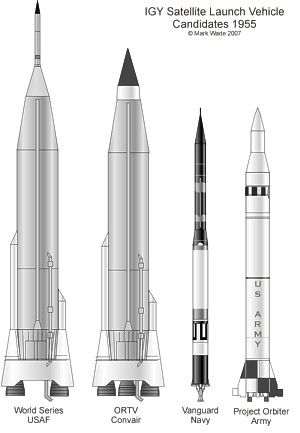
Home - Search - Browse - Alphabetic Index: 0- 1- 2- 3- 4- 5- 6- 7- 8- 9
A- B- C- D- E- F- G- H- I- J- K- L- M- N- O- P- Q- R- S- T- U- V- W- X- Y- Z
World Series
 IGY Sat LVs Credit: © Mark Wade |
Status: Concept 1956. Payload: 50 kg (110 lb). Thrust: 1,334.50 kN (300,008 lbf). Gross mass: 82,500 kg (181,800 lb). Height: 35.00 m (114.00 ft). Diameter: 3.05 m (10.00 ft). Apogee: 300 km (180 mi).
Beginning in 1954 the Army and Navy began advocating using modifications of their short-range rockets equipped with multiple upper stages to launch the first satellite into space during the 1957 International Geophysical Year. However a more reasonable and capable alternative would be to use the planned Atlas ICBM for the mission. The Air Force's General Bernard Schriever was in charge of the crash program to develop the Atlas ICBM, and was reluctant to lose a single month of schedule in order to pursue the peripheral scientific mission. The Eisenhower administration appointed the Stewart Committee on 26 May 1955 to select the best course of action. Goaded by interservice rivalry, the Air Force proposed its "World Series" launcher for the task in June 1955. This consisted of the Atlas A two-engined prototype of the missile topped with an Aerobee-Hi sounding rocket as a second stage. It was capable of putting a nominal payload (around 50 kg) into low earth orbit.
During the Committee's evaluation process, they visited Schriever's Western Development Division and received briefings on the status of the Atlas program. The Air Force took pains to point out the likelihood of delays in the highest-priority Atlas ICBM program if they were tasked to launch a scientific satellite as well. They seem not to have even mentioned the Atlas-boosted but deep black Corona spy satellite program. Evidently outside knowledge or interference in this was not desirable. In August 1955 the Stewart Committee, having taken on the Pentagon's desire for the IGY effort not to affect either the Air Force Atlas ICBM or Army Jupiter IRBM programs, selected the Navy's Vanguard as the IGY satellite booster.
Convair, however, saw a bright future for their Atlas rocket as a space launch vehicle. They made an unsolicited proposal before the Stewart Committee decision to the Air Force to use the three-engined Atlas C as an Orbital Research and Test Vehicle. This would boost a 230 kg satellite into orbit without the need for an upper stage. Nothing came of this proposal immediately.
In January 1956 the Air Force would begin study of a scientific version of the Corona reconnaissance satellite, boosted by an Atlas Agena two-stage booster. This could provide a US capability for launching a 1600 kg scientific satellite into orbit, as a follow-on to Vanguard. It also would provide cover for launches under the secret Corona program. This was shelved at the time but would become reality as the "Discoverer" program, a cover for early the Corona satellites.
On 1 February 1957 Air Force headquarters asked Schriever to provide a plan to fly a back-up scientific satellite for during the International Geophysical Year, in case Vanguard failed. The reply came a week later. $91 million would be required. But Atlas development was such that no launchings could be guaranteed before mid-1959. It was however possible, best case, that one or two launchings could be managed before the end of the IGY in 1958. The Air Force declined to spend the money.
The Soviet launch of Sputnik 1 in October 1957 had a political impact far beyond the loss of a few months in the Atlas operational date. Vanguard did indeed fail, and another Vanguard competitor, the Army's Redstone, managed to orbit a tiny satellite in January 1958. The Soviets launched the massive 1327-kg Sputnik 3 in May 1957, again humbling the Americans. The Convair Orbital Research and Test Vehicle concept was resurrected as Project Score, and Schriever was given funds to launch a satellite using an Atlas as soon as possible. A three-engined Atlas B launched the Score satellite into orbit in December 1958, doing something to restore US prestige. It remained attached to the Atlas, allowing the Americans to claim they had orbited a 4 metric ton satellite, although all but 70 kg of that was the Atlas itself.
LEO Payload: 50 kg (110 lb) to a 300 km orbit at 28.00 degrees.
Family: orbital launch vehicle. Country: USA. Agency: Convair.
Back to top of page
Home - Search - Browse - Alphabetic Index: 0- 1- 2- 3- 4- 5- 6- 7- 8- 9
A- B- C- D- E- F- G- H- I- J- K- L- M- N- O- P- Q- R- S- T- U- V- W- X- Y- Z
© 1997-2019 Mark Wade - Contact
© / Conditions for Use